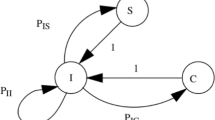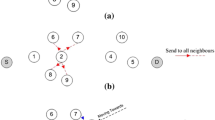Abstract
Routing in communication networks involves the indirection from a persistent name (ID) to a locator. The locator specifies how packets are delivered to a destination with a particular ID. Such a mapping is provided by a routing table entry, i.e. state. In a DTN, it is hard to maintain routing state because intermittent connectivity prevents protocols from refreshing states when they become inaccurate. In prior work, per-destination state mostly corresponds to utilities, where a high utility value about a destination implies that the probability to encounter the destination for the node maintaining the state is high. This approach depends on a particular mobility pattern in which nodes that met frequently in the past are likely to encounter in the future. In this paper, we use the concept of weak state that does not rely on external messages to remain valid (Acer et al. in MobiCom ’07: proceedings of the 13th annual ACM international conference on mobile computing and networking, pp 290–301, 2007). Our weak state realization provides probabilistic yet explicit information about where the destination is located. We build Weak State Routing protocol for Delay Tolerant Networks (WSR-D) that exploits the direction of node mobility in forwarding. It provides an osmosis mechanism to disseminate the state information to the network. With osmosis, a node has consistent information about a portion of the nodes that are located in regions relevant to its direction of mobility. Through simulations, we show that WSR-D achieves a higher delivery ratio with smaller average delay, and reduces the number of message transfers in comparison to Spray & Wait (Spyropoulos et al. in Proceedings of ACM SIGCOMM 2005 workshops: conference on computer communications, pp 252–259, 2005) and Spray & Focus (Spyropoulos et al. in IEEE/ACM Trans Netw, 16(1):77–90, 2008), a stateless and a utility based protocol, respectively.











Similar content being viewed by others
Notes
In this section, weak state refers to our realization not the general concept.
We set the parameter of number of replicas in SW and SF using Lemma 5.1 in [31] with α = 3.
When the dimensions of the area are not identical, i.e. size if x × y and x ≠ y, we refer to formula (21) in [4] to calculate the transition time.
References
Acer, U. G., Abouzeid A., & Kalyanaraman, S. (2009). An evaluation of weak state mechanism design for indirection in dynamic networks. INFOCOM’09: The 28th IEEE international conference on computer communications (pp. 1125–1133).
Acer, U. G., Kalyanaraman S., & Abouzeid, A. A. (2007). Weak state routing for large scale dynamic networks. In MobiCom ’07: Proceedings of the 13th annual ACM international conference on mobile computing and networking (pp. 290–301).
Balasubramanian, A., Levine, B., & Venkataramani, A. (2007). Dtn routing as a resource allocation problem. SIGCOMM Computer Communication Review, 37(4), 373–384.
Bettstetter, C., Hartenstein, H., & Perez-Costa, X. (2004). Stochastic properties of the random waypoint mobility model. Wireless Networks, 10(5), 555–567.
Bloom, B. (1970). Space/time trade-offs in hash coding with allowable errors. Communications of the ACM, 13(7), 422–426.
Burgess, J., Gallagher, B., Jensen, D., & Levine, B. N. (2006). Maxprop: Routing for vehicle-based disruption-tolerant networks. INFOCOM 2006 25th IEEE international conference on computer communications proceedings (pp. 1–11).
Clark, D. D. (1988). The design philosophy of the DARPA internet protocols. SIGCOMM ’88: Symposium proceedings on communications architectures and protocols (pp. 106–114).
Daly, E. M., & Haahr, M. (2007). Social network analysis for routing in disconnected delay-tolerant manets. MobiHoc ’07, pp. 32–40.
Ferreira, A. (2004). Building a reference combinatorial model for manets. IEEE Network, 18(5), 24–29.
Grossglauser, M., & Tse, D. N. (2002). Mobility increases the capacity of ad hoc wireless networks. IEEE/ACM Transactions on Networking, 10(4), 477–486.
Haas, Z. J., Halpern, J. Y., & Li, L. (2006). Gossip-based ad hoc routing. IEEE/ACM Transactions on Networking, 14(3), 479–491.
Hyytia, E., Lassila, P., & Virtamo, J. (2006). Spatial node distribution of the random waypoint mobility model with applications. IEEE Transactions on Mobile Computing, 5(6), 680–693.
Jain, S., Fall, K., & Patra, R. (2004). Routing in a delay tolerant network. Computer Communication Review, 34(4), 145–157.
Ji, P., Ge, Z., Kurose, J., & Towsley, D. (2007). A comparison of hard-state and soft-state signaling protocols. IEEE/ACM Transactions on Networking, 15(2), 281–294.
Johnson, D. B., & Maltz, D. A. (1996). Dynamic source routing in Ad Hoc wireless networks. Mobile Computing, Vol. 353. Kluwer Academic Publishers.
Jones, E. P. C., Li, L., & Ward, P. A. S. (2005). Practical routing in delay-tolerant networks. In WDTN ’05: Proceedings of the 2005 ACM SIGCOMM workshop on delay-tolerant networking (pp. 237–243).
Karp, B., & Kung, H. (2000). GPSR: Greedy perimeter stateless routing for wireless networks. In Proceedings of the annual international conference on mobile computing and networking, MOBICOM (pp. 243–254).
Keränen, A., Ott, J., & Kärkkäinen, T. (2009). The ONE simulator for DTN protocol evaluation. In SIMUTools’09: Proceedings of the 2nd international conference on simulation tools and techniques, ICST.
Kumar, A., Xu, J., & Zegura, E. . (2005). Efficient and scalable query routing for unstructured peer-to-peer networks. Proceedings of IEEE INFOCOM, 2, 1162–1173.
LeBrun, J., Chuah, C. N., Ghosal, D., & Zhang, M. (2005). Knowledge-based opportunistic forwarding in vehicular wireless ad hoc networks. IEEE Vehicular Technology Conference, 61, 2289–2293.
Leontiadis, I., & Mascolo, C. (2007). Geopps: Geographical opportunistic routing for vehicular networks. World of Wireless, Mobile and Multimedia Networks, WoWMoM, pp. 1–6.
Lindgren, A., Doria, A., & Schelen, O. (2004). Probabilistic routing in intermittently connected networks. Workshop on Service Assurance with Partial and Intermittent Resources, SAPIR 2004, pp 239–54.
Liu, C., & Wu, J. (2008). Routing in a cyclic mobispace. MobiHoc ’08, pp. 351–360.
Perkins, C. E., & Royer, E. (1999). Ad-hoc on-demand distance vector routing. Second IEEE workshop on mobile computing systems and applications. WMCSA’99. (pp. 90–100).
Piorkowski, M., Sarafijanovic-Djukic, N., & Grossglauser, M. (2009). CRAWDAD data set epfl/mobility (v. 2009-02-24). Downloaded from http://crawdad.cs.dartmouth.edu/epfl/mobility.
Piorkowski, M., Sarafijanovic-Djukic, N., & Grossglauser, M. (2009). A parsimonious model of mobile partitioned networks with clustering. 1st international conference on communication systems and networks and workshops, COMSNETS 2009.
Raman, S., & McCanne, S. (1999). Model, analysis, and protocol framework for soft state-based communication. Computer Communication Review, 29(4), 15–25.
Seth, A., Kroeker, D., Zaharia, M., Guo, S., & Keshav, S. (2006). Low-cost communication for rural internet kiosks using mechanical backhaul. Proceedings of the annual international conference on mobile computing and networking, MOBICOM (pp. 334–345).
Shah, R. C., Roy, S., Jain, S., & Brunette, W. (2003). Data mules: Modeling and analysis of a three-tier architecture for sparse sensor networks. Ad Hoc Networks, 1(2–3), 215–233.
Spyropoulos, T., Psounis, K., & Raghavendra, C. S. (2005). Spray and wait: An efficient routing scheme for intermittently connected mobile networks. In Proceedings of ACM SIGCOMM 2005 workshops: Conference on computer communications (pp. 252–259).
Spyropoulos, T., Psounis, K., & Raghavendra, C. S. (2008). Efficient routing in intermittently connected mobile networks: The multiple-copy case. IEEE/ACM Transactions on Networking, 16(1), 77–90.
Vahdat, A., & Becker, D. (2000). Epidemic routing for partially connected Ad Hoc networks. Tech. rep., Department of Computer Science, Duke University, Durham, NC, http://citeseer.ist.psu.edu/vahdat00epidemic.htm.
Zhao, W., Ammar, M., & Zegura, E. (2004). A message ferrying approach for data delivery in sparse mobile ad hoc networks. In Proceedings of the international symposium on mobile Ad Hoc networking and computing (MobiHoc) (pp. 187–198).
Acknowledgments
The material presented in this paper is based upon work supported by the National Science Foundation under Grant No. 0546402 and 0627039. Any opinions, findings, and conclusions or recommendations expressed in this material are those of the authors and do not necessarily reflect the views of the National Science Foundation.
Author information
Authors and Affiliations
Corresponding author
Rights and permissions
About this article
Cite this article
Acer, U.G., Kalyanaraman, S. & Abouzeid, A.A. DTN routing using explicit and probabilistic routing table states. Wireless Netw 17, 1305–1321 (2011). https://doi.org/10.1007/s11276-011-0350-y
Published:
Issue Date:
DOI: https://doi.org/10.1007/s11276-011-0350-y




